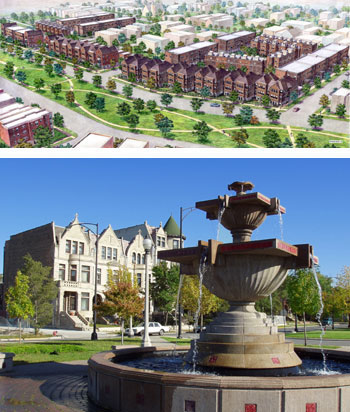 No, Jazz on the Boulevard is not, as the name might suggest, a nightclub, but the development of new homes by the Thrush Companies is meant to create the same sense of excitement and history that a jazz club on the historic Near South Side would evoke.
No, Jazz on the Boulevard is not, as the name might suggest, a nightclub, but the development of new homes by the Thrush Companies is meant to create the same sense of excitement and history that a jazz club on the historic Near South Side would evoke.
This, after all, was the area where the likes of Louis Armstrong and Duke Ellington could be heard at the Regal Theater and other renowned clubs that lined 47th Street in the age of jazz.
“In naming the development, we wanted to go back to the roots of the community,” says David Chase, president and CEO of Thrush Companies, co-developer of the project along with Granite
Development and Heartland Housing. “And there’s something about that word ‘Jazz’ that carries a certain resonance.”
The roots of North Kenwood-Oakland, where Jazz on the Boulevard is located, with a sales center at 4207 S. Cottage Grove, actually predate the neighborhood’s days as a Mecca for Jazz and continue to resonate today.
In the mid-19th century, the sons of Philadelphia banker Francis M. Drexel donated the land for Drexel Boulevard to the city. Frederick Law Olmstead conceived the network of beautifully landscaped boulevards that surround the heart of the city – and are at their finest on the South Side – in 1870. In the following decades, stately mansions were built along lushly landscaped boulevards, and Drexel, where Jazz is being constructed between 41st Street and 42nd Place, is among the finest.
Although many of the area’s historic homes have been lost, many prime examples remain along Drexel, a grassy thoroughfare with a landscaped median that at 100 feet, is wider than many parks. Newcomers to the area are often shocked at the beauty of this hidden gem just 15 minutes south of the Loop, the august greystones that have been lovingly restored, the lush landscaping that keeps the city at bay and refurbished Mandrake Park with its gurgling fountain, the northern gateway to the neighborhood.
Gaps on the boulevard remain, though a number have been filled in with new luxury single-family homes, and the largest open space soon will be home to the new Jazz on the Boulevard. The 137-unit residential development includes a wide variety of housing types and prices, each named after a famous jazz musician. The condos have one to three bedrooms and start at 900 square feet. The townhouses have two bedrooms and start at 2,000 square feet, while single-family rowhomes have about 3,000 square feet.
At press time, prices ranged from the low $200s for condos to the high $500s for the rowhomes. The project also includes a number of rental apartments, some of which are reserved for Chicago Housing Authority residents, a mixed-income approach to development that is becoming common on former CHA and city-owned property.
And there is “workforce” housing, affordable rental units for families earning up to 120 percent of the metropolitan area’s median income. A portion of the for-sale units also are workforce homes, so dubbed because they are designed to be affordable for teachers, city workers and others who have been priced out of the Chicago market.
“Jazz on the Boulevard offers a unique opportunity to restore the original grandeur to what was historically one of the finest examples of Chicago’s boulevard system,” Chase says.
In keeping with that historic character, the homes have masonry facades and stone detailing on all sides. Bays, balconies and arches provide visual interest, while decorative wrought iron fencing adds security and helps define the community. The center of the development contains a landscaped park-like space where residents can gather and children can play.
“We were determined to create a nice presence on Drexel, and therefore much of our design inspiration and many of our architectural cues – scales, windows, colors, materials and the like – are derived from the adjacent and surrounding environment,” says Steve Ryniewicz, of FitzGerald Associates, the architects for the project.
In addition to the ornamental wrought iron fencing, exterior amenities include Victorian-inspired designs, lavish landscaping, decorative courtyard lighting and spacious decks, balconies and yards.
Unit features include nine-foot ceiling heights, hardwood flooring in living areas, balconies per plan, ceramic tile flooring in kitchens, Moen faucets, garbage disposals, brushed chrome hardware, accent lighting in foyers and kitchens, soaking tubs, ceramic tile baths, washer and dryer hookups and multimedia prewiring.
The first phase of the project consists of seven townhomes and 52 one-, two- and three-bedroom units with deliveries to begin in May 2005. At press time, five of the townhomes and about half of the condos had been sold, according to Thrush sales agent Robbie Davis.
Construction is underway on the second phase of Jazz, which comprises 16 duplexes, six six-flats and 19 townhomes, with deliveries scheduled for October 2005. At press time, about half of these units were still available for sale.
Construction of the seven rowhomes will begin in June 2005, and Thrush has tentative plans to build additional rowhomes on contiguous property in the near future.
“This entire neighborhood is an explosion of development,” says Chase. “Even though we were one of the first developers in the area in the early 1990s, I am still amazed when I see the rehab and conversion of countless buildings that were boarded up just a few months ago.”
The Thrush sales office for Jazz on the Boulevard is located at 4207 S. Cottage Grove (www.jazzontheboulevard.com).
